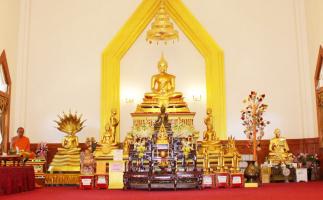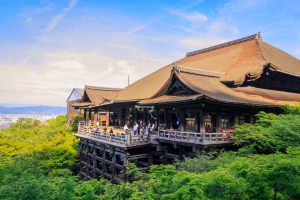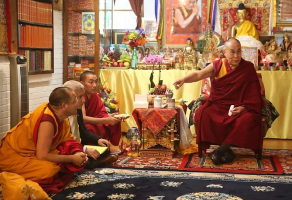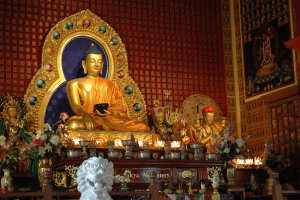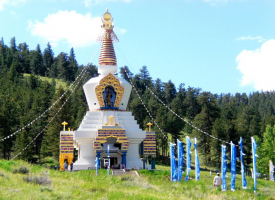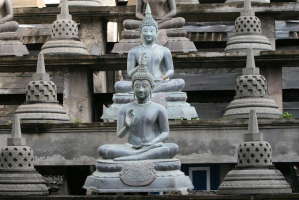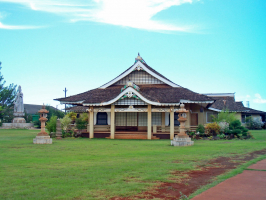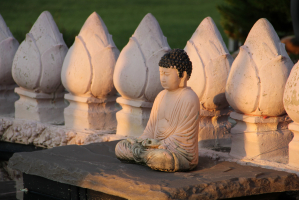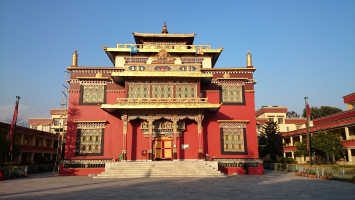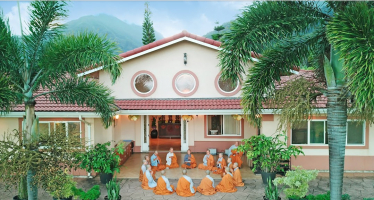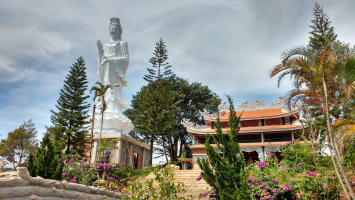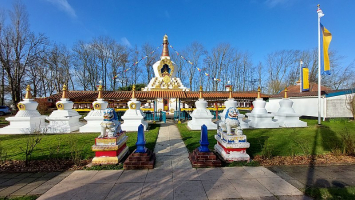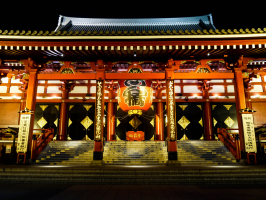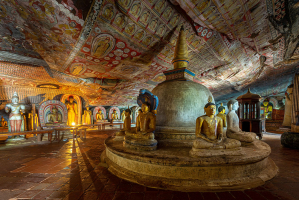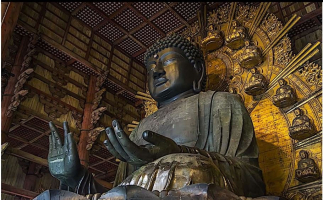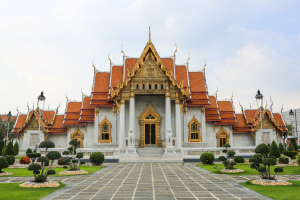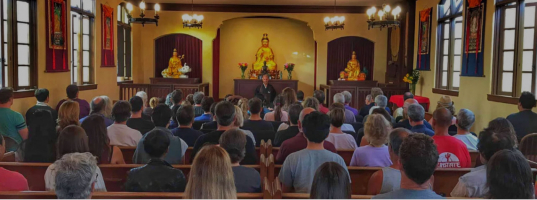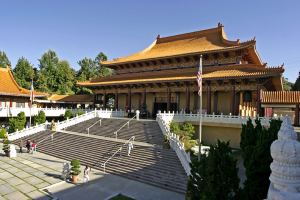Top 10 Best Buddhist Temples in Indonesia
We're diving into a world of ancient history, spirituality, and stunning architecture. That's how we want to talk about the best Buddhist temples in Indonesia. ... read more...Join us on a fascinating tour through the poetic landscapes, exquisite carvings, and majestic architectural works. Learn about their histories, immerse yourself in the tranquility, and unearth the unique blend of tradition and natural beauty.
-
In Central Java, Indonesia, Borobudur is the world's largest Buddhist temple and a marvel of ancient architecture. Constructed during the Sailendra dynasty in the 9th century, this UNESCO World Heritage Site embodies Mahayana Buddhist beliefs and principles.
The temple, built atop a hill overlooking breathtaking landscapes, consists of nine stacked platforms: six square platforms below and three circular platforms above. The temple's design follows a path visitors traverse, symbolizing a spiritual pilgrimage. Starting at the base and circling the platforms while ascending, one moves from the realm of desire to the realm of enlightenment, symbolizing the path to Nirvana.
At the top, there used to be a big thing called a stupa that showed enlightenment. Even though it's not there anymore, the view from that spot is still incredible. It's like a reminder of how special the place is.
Borobudur's walls are adorned with detailed carvings, totaling over 2,600 individual narrative panels and more than 500 Buddha statues. They depict the life of Buddha, illustrating his teachings, past lives, and the principles of Buddhism.
As one of the best Buddhist temples in Indonesia, Borobudur is known as a symbol of Indonesia's cultural identity and a reminder of the country's glorious past. This is a must-visit destination for anyone eager to witness the splendor of ancient Buddhist architecture and spirituality.
Address: Jl. Badrawati, Kw. Candi Borobudur, Borobudur, Kec. Borobudur, Kabupaten Magelang, Jawa Tengah, Indonesia
Opening Hours: 6:30 a.m.–4:30 p.m. (Monday–Sunday)
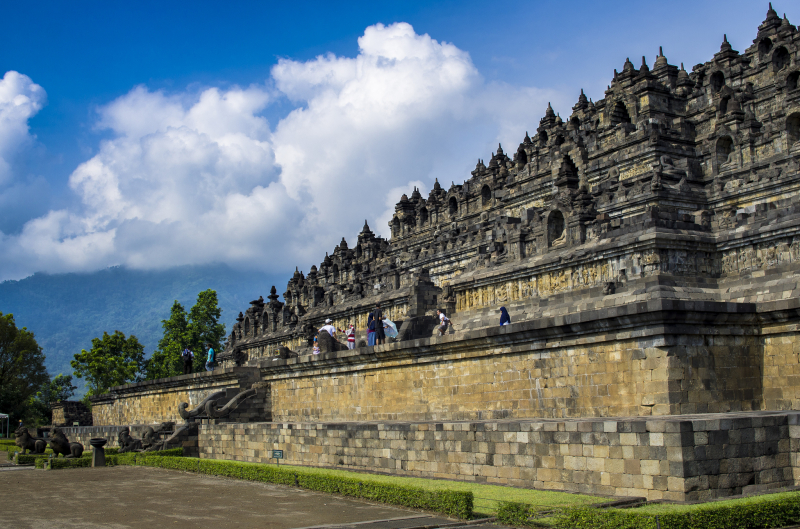
Photo by https://www.worldhistory.org/Borobudur/ 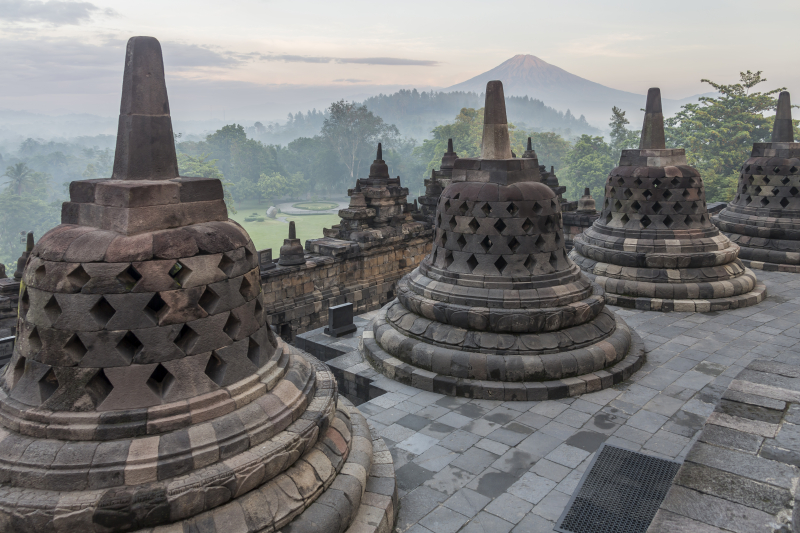
Photo by https://commons.wikimedia.org/wiki/File:Borobudur-Temple-Park_Indonesia_Stupas-of-Borobudur-14.jpg -
Plaosan Temple, nestled in Central Java, Indonesia, is a real gem when it comes to ancient Buddhist temples. Dating back to the 9th century, this temple showcases a mix of both Buddhist and Hindu influences in its architecture, making it a unique cultural spot and one of the best Buddhist temples in Indonesia.
What's fascinating about Plaosan is its structure—it's actually a complex made up of two main temples, known as Plaosan Lor and Plaosan Kidul. These temples stand tall with impressive stone carvings and intricate designs that tell stories of ancient times.
The structures boast remarkable stone carvings depicting scenes from Buddhist and Hindu tales, showcasing cultural syncretism and artistic finesse. The temple walls are adorned with intricate reliefs portraying stories from Jataka, the life of Buddha, and scenes from Hindu epics like the Ramayana and Mahabharata.
The temple complex has a tranquil vibe, making it a peaceful place to wander and soak up the ancient vibes. Its off-the-beaten-path appeal makes it a haven for history buffs and those seeking a quieter, more intimate experience with Indonesia's rich cultural heritage.
Visiting Plaosan Temple gives you a glimpse into the artistic and spiritual world of ancient Indonesia. As you explore its nooks and crannies, you'll find yourself transported back in time, surrounded by the echoes of centuries-old stories etched into its stones.
Address: Jl. Candi Plaosan, Plaosan Lor, Bugisan, Kec. Prambanan, Kabupaten Klaten, Jawa Tengah 57454, Indonesia
Opening Hours: 7:30 a.m.–4:30 p.m. (Monday, Tuesday, Wednesday, Thursday, Saturday, Sunday); 8 a.m.–4 p.m. (Friday)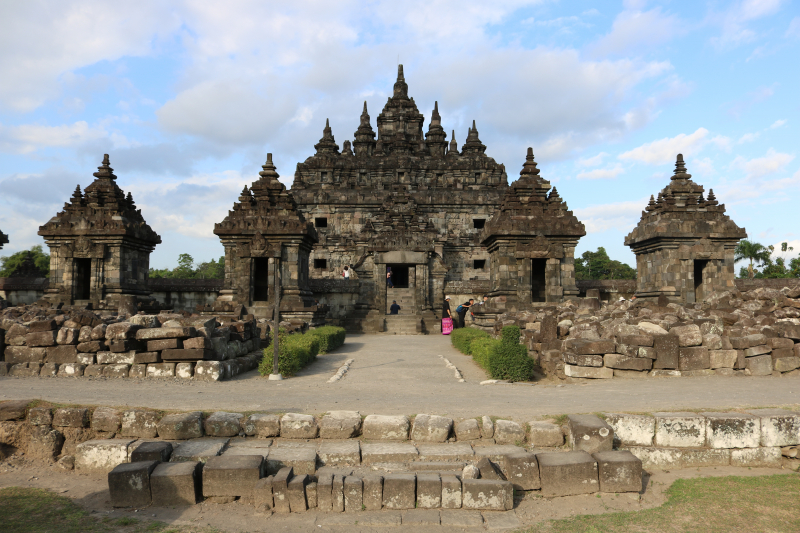
Photo by https://commons.wikimedia.org/wiki/File:Candi_Plaosan_Lor_%28North_Plaosan_Temple%29_from_Klaten,_Central_Java,_Indonesia_05.jpg 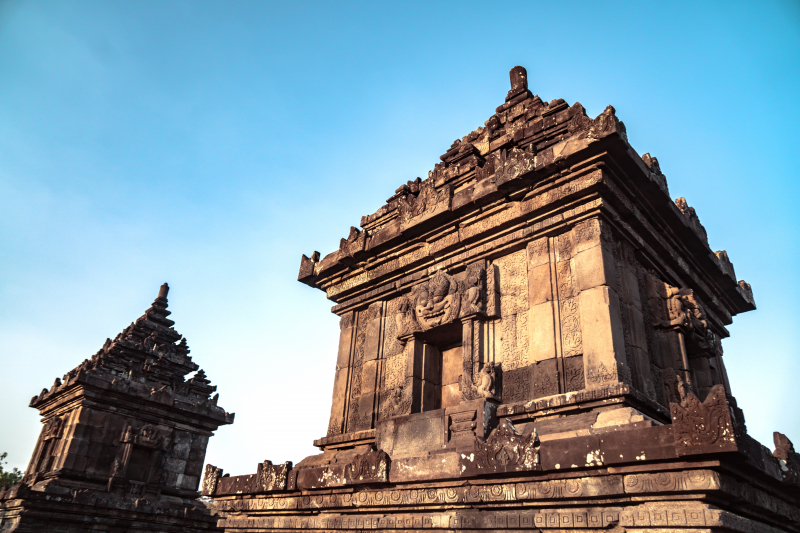
Photo by https://commons.wikimedia.org/wiki/File:Senja_di_Candi_Plaosan.jpg -
The Mendut Buddhist Monastery is a peaceful retreat situated in Mendut village. Within an easy two-minute stroll from Candi Mendut, a Mahayana Buddhist temple with roots tracing back to the 9th century under King Indra of the Syailendra dynasty, this monastery offers a serene escape.
The monastery's grounds host an array of Buddhist sculptures depicting various poses, including a reclining Buddha statue tucked within a small temple to the left of the entrance gates. Towards the rear of the monastery, a striking tower adorned with intricate carvings of the Buddha's head on each face stands tall. Inside, visitors find metal Buddhist statues placed at the center, adding to the site's allure.
Exploring the grounds reveals a myriad of captivating sculptures and architectural wonders, as well as an atmosphere of calm and beauty. For visitors exploring the nearby Borobudur temple, taking an hour to visit the Mendut Buddhist Monastery is a fantastic addition to the itinerary.
Words may not fully capture the experience, but the impressive beauty and peaceful ambiance of this monastery make it a must-see destination in Indonesia. It's a serene haven, inviting all to appreciate its simplicity and the spiritual aura that graces the surroundings. The Mendut temple nearby is also another great choice for visitors.
Address: Jl. Mayor Kusen, Sumberrejo, Mendut, Kec. Mungkid, Kabupaten Magelang, Jawa Tengah 56501, Indonesia
Opening Hours: 7 a.m.–7 p.m. (Monday–Sunday)
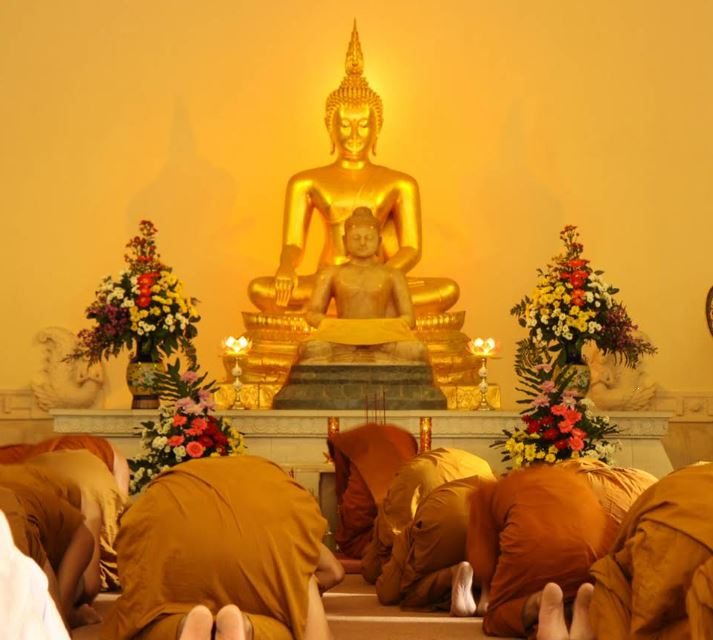
Screenshot of https://mendut.business.site/ 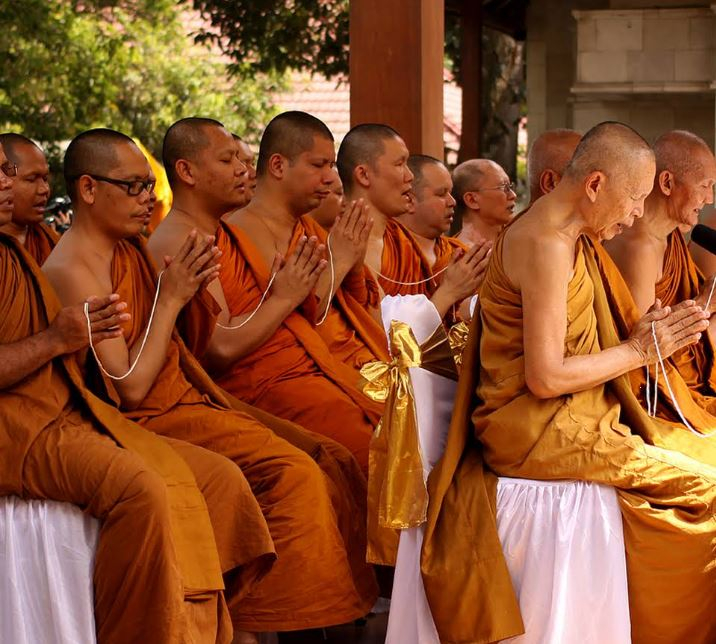
Screenshot of https://mendut.business.site/ -
Sewu Temple, another wonderful temple in Central Java, Indonesia, is a remarkable testament to ancient Buddhist architecture. This temple complex, whose name translates to "a thousand temples," is a captivating site just a stone's throw away from the famed Prambanan temple.
First constructed in the 8th century, today, Sewu Temple boasts the grandeur of a bygone era. Though not as widely recognized as some other temples, its historical and architectural significance is undeniable. The complex comprises numerous small shrines arranged in concentric squares, surrounding a central temple adorned with striking stone carvings.
The main temple, dedicated to Buddha, presents intricate carvings and captivating sculptures that depict various aspects of Buddhist teachings and stories. The temple's design, though predominantly Buddhist, also incorporates elements of Hindu influence, reflecting the cultural fusion prevalent during its construction.
As you explore the grounds, you'll encounter a multitude of smaller shrines arranged symmetrically, creating a captivating visual panorama. Each shrine houses a statue of Buddha, adding a spiritual ambiance to the surroundings. With its vastness and historical importance, the temple complex has earned recognition as one of Indonesia's best-preserved ancient Buddhist sites.
While not as bustling with visitors as some other sites, Sewu Temple holds its own charm, inviting those looking for a quieter, more intimate encounter with Indonesia's ancient past. Its tranquil atmosphere and architectural marvels make it a captivating stop for history enthusiasts and anyone fascinated by the cultural legacy of Indonesia.Address: Jl. Raya Solo, Yogyakarta No.KM.16, Bugisan, Kec. Prambanan, Kabupaten Sleman, Daerah Istimewa Yogyakarta, Indonesia
Opening Hours: 6 a.m.–5 p.m. (Monday–Sunday)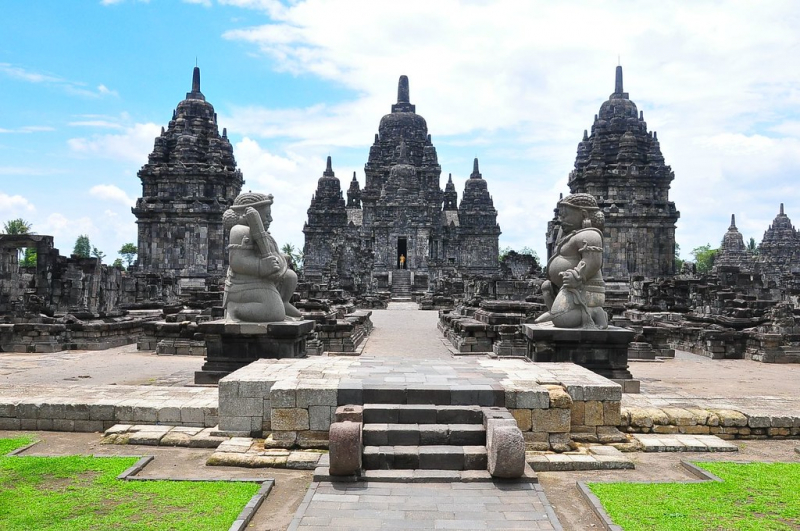
Photo by Julien on Flickr (https://www.flickr.com/photos/djou/6501548665) 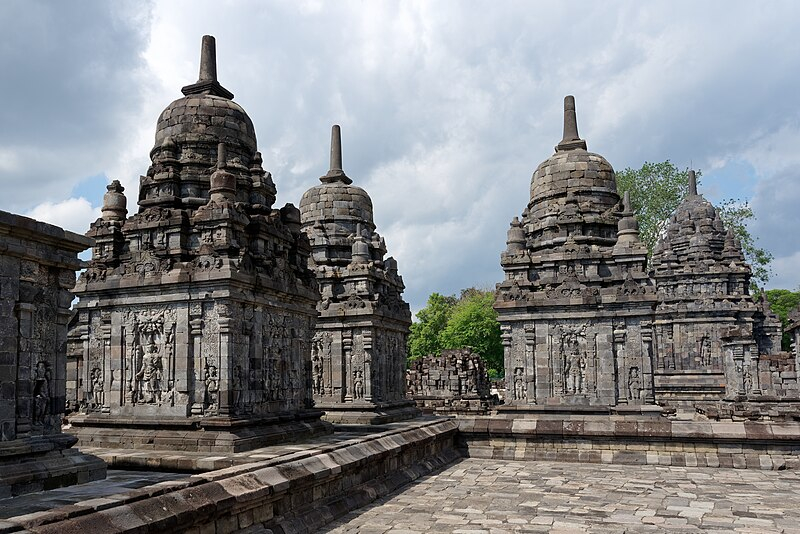
Photo by https://commons.wikimedia.org/wiki/File:Candi_Sewu,_Central_Java,_Indonesia,_20220818_1354_9257.jpg -
Kalasan Temple is a real ancient wonder nestled between Yogyakarta and Solo, just a hop from Prambanan Temple in Central Java, Indonesia. It’s said to be even older than the colossal Borobudur! Talk about history vibes!
This temple's home turf is in Tirtomantani Village, Sleman Regency, Yogyakarta. This place dates back to 778 AD and has a story etched in stone. Built by Guru Sang Raja Sailendravamçatilaka, it was all about honoring the goddess Tara and housing Buddhist monks from the Sailendra royal families.
When you step inside, it's like walking into a treasure trove of art. The temple’s got these awesome rooms and gates. Each is decked out with these intricate Kala-Makara designs that make you go, "Wow!" Here's a cool nugget: the rooms once held statues of bodhisattvas. There are no statues there now, just lotus pedestals, hinting at its history. Step outside, and you'll spot carvings that tell celestial tales—the kind that used to be the abode of gods.
Now, the roof's a standout feature. It's shaped like an octagon and flaunts carved images of Buddha and his buddies, the bodhisattvas. It's like an ancient art gallery up there! Facing east, the main room used to house this massive bronze statue of Boddhisattvadevi Tara. Imagine a statue reaching around 4 meters tall, sitting all regal on a throne adorned with makara, lions, and elephants.Kalasan Temple deserves to be one of the best Buddhist temples in Indonesia. This is truly a journey into the cultural tapestry of ancient Java, where history and art come together in the midst of the lush Prambanan valley.
Address: 6FMC+3WW, Jl. Raya Yogya, Solo, Suryatmajan, Danurejan, Daerah Istimewa Yogyakarta, Indonesia
Opening Hours: 8 a.m.–5 p.m. (Monday–Sunday)
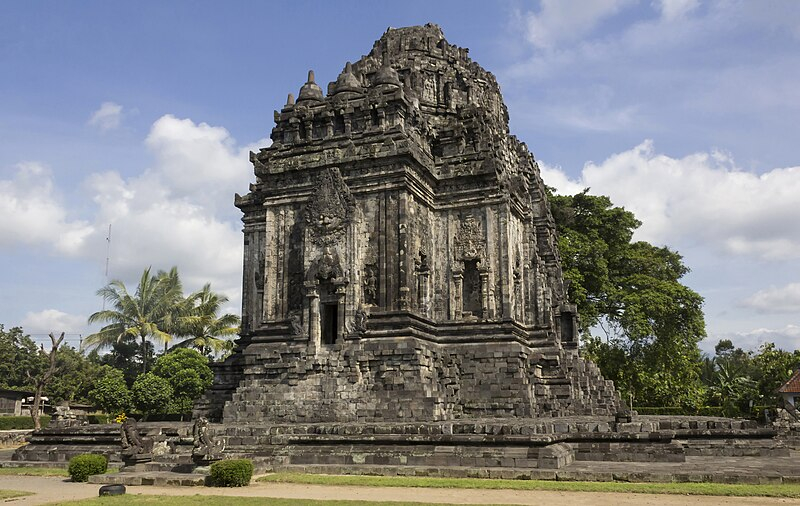
Photo by https://commons.wikimedia.org/wiki/File:Kalasan_Temple_from_the_north-east,_23_November_2013.jpg 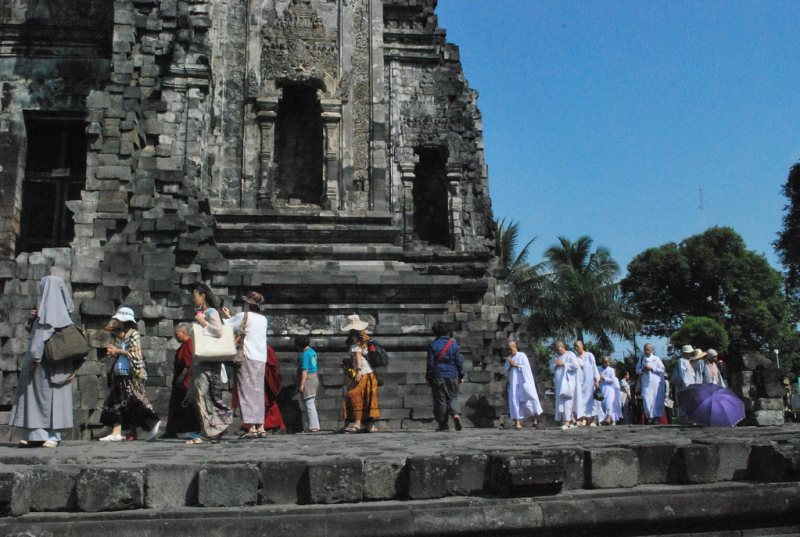
Photo by tian yake on Flickr (https://www.flickr.com/photos/tianyake/27320772523) -
The Brahma Vihara Arama Buddhist Temple in North Bali is a serene spot that's way more than just a temple. Built-in 1970, it's like a mini version of Borobudur, Indonesia's famous Buddhist temple, but with its own unique Balinese flair.
When you step in, it's like entering a calming oasis—lush gardens, statues, and quiet spots are everywhere. The design mixes Balinese style with Buddhist vibes, making it unique and inviting. The carved gates and pagodas add a touch of artistry that blends in perfectly with the chill vibe. The main prayer hall, called the "Brahma Vihara," is the heart of the place. Inside, colorful murals tell stories from Buddhism, setting a serene vibe.The statues here are a sight! This stunning Buddha statue is covered in gold, a gift from Thailand and Sri Lanka. They’ve also got 31 rock-carved Buddha statues, symbolizing levels beyond nirvana. People come here not just to see these statues but also to feel the zen vibes through meditation.
Brahma Vihara Arama Buddhist Temple isn't just about prayers—it's a cultural treat. It's where you can soak up the art, take a breather, and feel the tranquility that fills every corner. So, if you're up for a chill time or a bit of soul-searching, this temple's the spot to be in Bali.
Address: Banjar Dinas Tangeb, Banjar Tegeha, Kec. Banjar, Kabupaten Buleleng, Bali 81152, Indonesia
Opening Hours: 8 a.m.–6 p.m. (Monday–Sunday)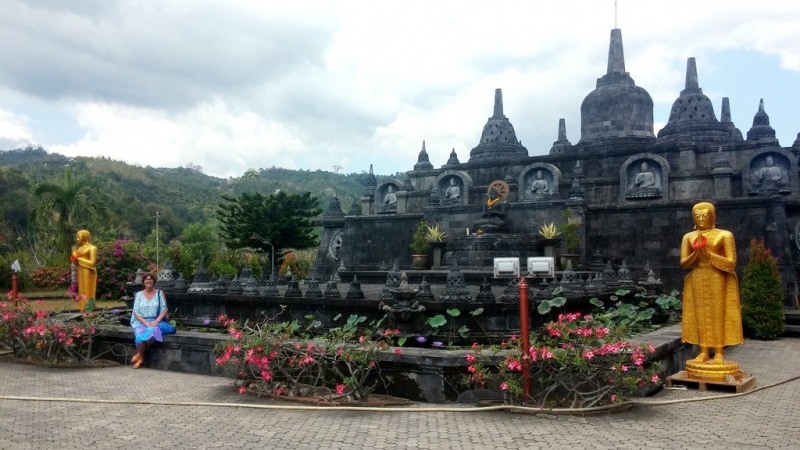
Photo by Sue on Flickr (https://www.flickr.com/photos/29204155@N08/36517734721) 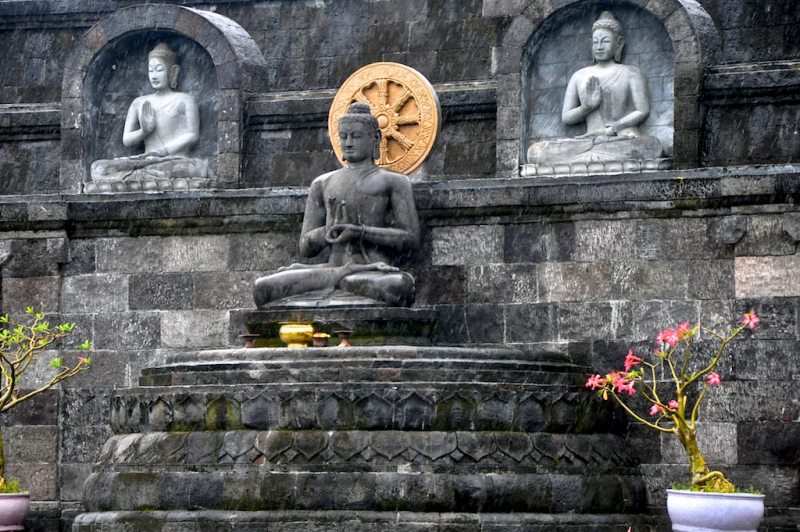
Photo by Mariska Richters on Flickr (https://www.flickr.com/photos/mariskar/4612558975/) -
Candi Banyunibo, a lesser-known gem in Central Java, Indonesia, is a petite yet mesmerizing Buddhist temple. This temple might not be as massive as Borobudur or Prambanan, but it’s got its own magic.
Dating back to the 9th century, this temple tells tales of ancient times through its cool design. Picture this: a curved rooftop with a solo stupa on top—different from other Buddhist temples in the area. Some say the curve represents lotus petals or mimics the old-school Javanese roofs made from special fibers, like those found in Balinese temples.
The details here are like a history book in stone. Stairs and portals rock in the classic Kala-Makara style, a common sight in ancient Central Javanese temples. The niches tell tales, too, featuring Bodhisattvas and Taras holding flowers. Inside, the walls showcase Hariti, Vaisravana, and a mysterious figure, possibly a temple supporter, chilling under an umbrella with servants.
Back in 1940, this place was found in ruins, but they didn't leave it like that! From 1942 to 1962, they tried to piece it back together, but wars and revolutions got in the way. Fast forward to 1978, and voila! Banyunibo stood tall again, all rebuilt and proud.
Sure, it might not be the talk of the town, but Candi Banyunibo has its own story to tell. It's a peaceful spot where ancient history whispers through its stone carvings, inviting you to take a chill stroll through Indonesia's Buddhist world.
Address: 6FFV+7V9 Kawasan Wisata Candi Banyunibo, Cepit, Bokoharjo, Kec. Prambanan, Kabupaten Sleman, Daerah Istimewa Yogyakarta 55572, Indonesia
Opening Hours: 6 a.m.–6 p.m. (Monday–Sunday)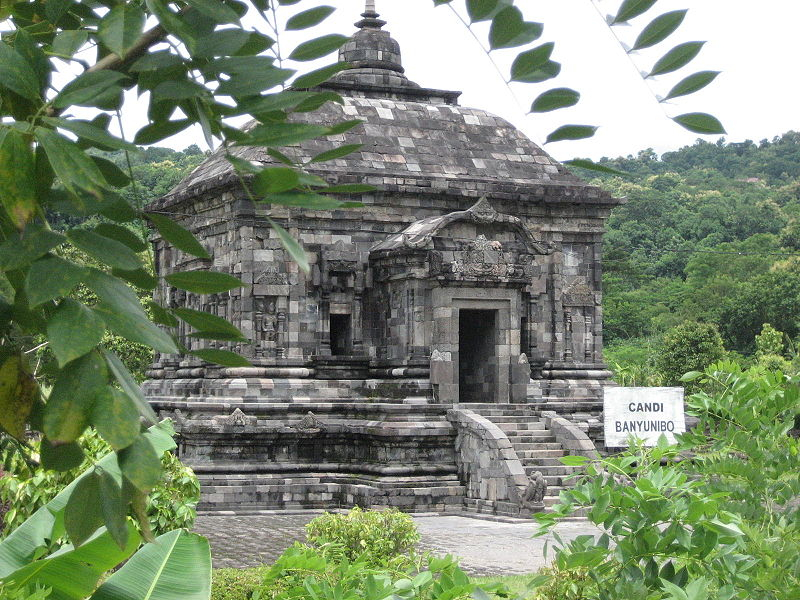
Photo by https://commons.wikimedia.org/wiki/File:Candi_Banyunibo.JPG 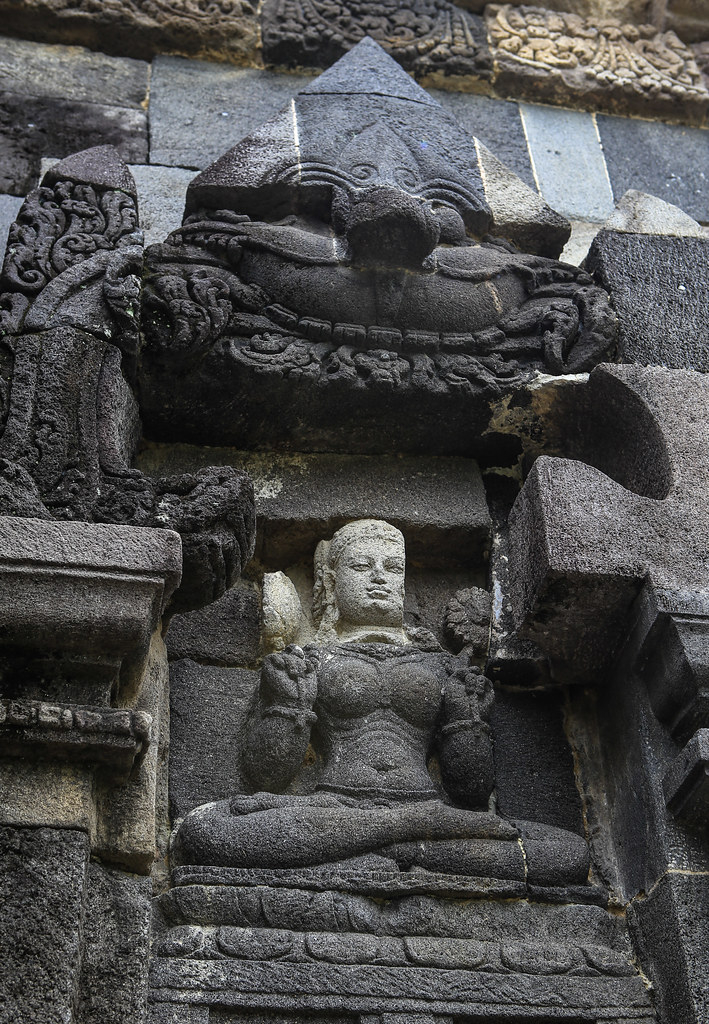
Photo by carol mitchell on Flickr (https://www.flickr.com/photos/webethere/46280172175/) -
Pawon Temple, a hidden gem between Borobudur and Mendut in Central Java, Indonesia, may be small but carries a hefty dose of historical charm. Built-in the 9th century, it is crucial in the sacred Vesak pilgrimage.
This little gem got its name from the Javanese word for "kitchen," but folks also link it to a place filled with dust. Some think it might've held the ashes of King Indra, while others say it was where the Flaming Thunderbolt, his supposed weapon, was kept.
Located between Borobudur and Mendut, this temple is like a vital dot in a sacred line. Despite its size, it’s got some serious charm. Picture this: a rectangular platform with a curvy 20-sided base, giving it a unique vibe compared to other temples. Like Hindu temples, it's slim and decked with flower and vine sculptures. Plus, its entrance rocks this Kala Makara arch—kind of a signature thing in Javanese temples.
What’s neat are the carvings on the walls. They're like a storybook etched in stone, featuring Bodhisattvas, Taras, and this divine tree of life called Kalpataru. The temple's chamber might be empty now, but they say it once held a statue that radiated rays—some bronze Bodhisattva, perhaps?
Even though Pawon Temple’s not the biggest star in the show, it’s a history lover's dream. Its charming design and mysterious background earn it the title of "the jewel of Javanese temple architecture." It might be small, but it’s big on history and a must-see for anyone curious about the best Buddhist temples in Indonesia.
Address: 96V9+GRV, Brojonalan, Dusun 1, Wanurejo, Kec. Borobudur, Kabupaten Magelang, Jawa Tengah 56553, Indonesia
Opening Hours: 7 a.m.–11 a.m.; 12 p.m.–4 p.m. (Monday–Sunday, closed on Thursday)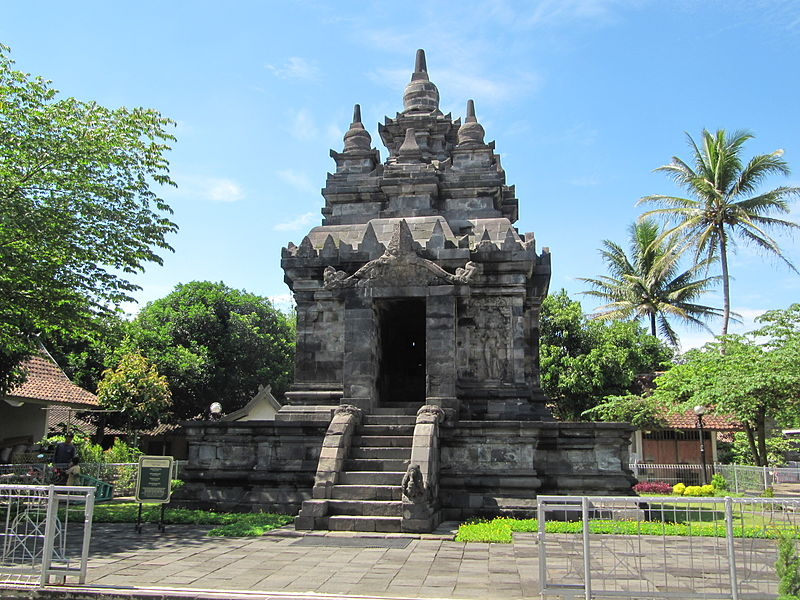
Photo by https://commons.wikimedia.org/wiki/File:Candi_Pawon_%282%29.JPG 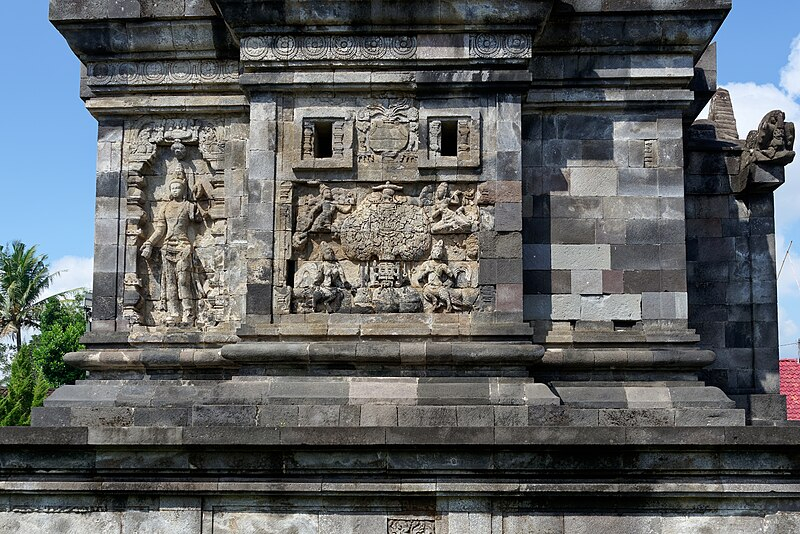
Photo by https://commons.wikimedia.org/wiki/File:Reliefs,_Candi_Pawon,_Central_Java,_20220817_0936_8654.jpg -
Nestled in the foothills of Mt. Arjuna, the Sumberawan Temple emerges as a hidden treasure in East Java, Indonesia. Situated approximately 1 kilometer from the Singhasari temple gateway, which exhibits Hindu architectural style, reaching Sumberawan Temple is an enchanting journey. Visitors traverse a path weaving through rice fields and along a river for about 500 meters in the charming Sumberawan village.
A peaceful ambiance complements the temple and features a natural water source, with the pool's water believed to possess rejuvenating properties. Many visitors take the opportunity for a refreshing dip, considering it a must-try experience.The temple itself is a testament to simplicity, following a rectangular structure without ornate accessories. It stands as a beautiful example of Buddhist architecture in East Java. Beyond its historical and architectural allure, the location adds to its charm, offering a peaceful retreat amid nature.
Sumberawan Temple comes to life during 'Waisak,' a significant Buddhist holiday celebrating the life of Buddha. Buddhists gather here, especially in the evening, to engage in meditation sessions and commemorate Buddha's teachings.
While not as widely known as some other regional temples, Sumberawan Temple captivates visitors with its historical significance, tranquil atmosphere, and the spiritual energy that permeates the surroundings. So, if you are looking for a beautiful temple in Java to visit and find a calm moment from the hustle and bustle of life, Sumberawan Temple is a perfect choice.
Address: 4JVV+JWX, Sumberawan, Toyomarto, Singosari, Bodean Krajan, Toyomarto, Kec. Singosari, Kabupaten Malang, Jawa Timur 65153, Indonesia
Opening Hours: 8 a.m.–4 p.m. (Monday–Sunday)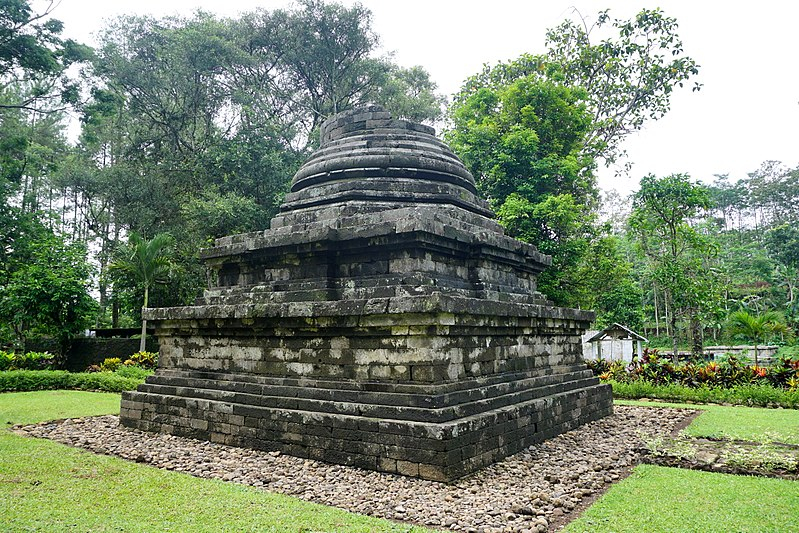
Photo by https://commons.wikimedia.org/wiki/File:050_View_from_South,_Candi_Sumberawan_%2840372729382%29.jpg 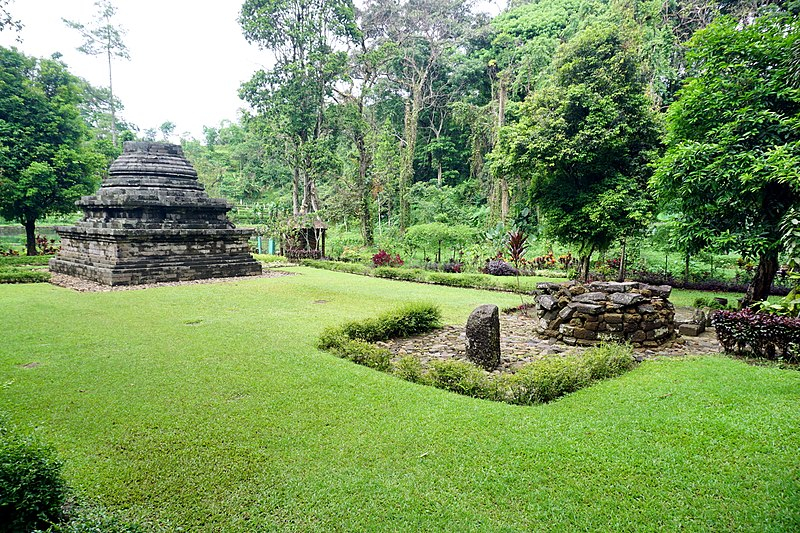
Photo by https://commons.wikimedia.org/wiki/File:051_Stupa_and_Perwara,_Candi_Sumberawan_%2840372723112%29.jpg -
Nestled in the lush landscapes near the Kampar River, Muara Takus Temple is a significant archaeological site. The temple complex features a collection of stupas and Buddhist relics that reflect the influence of ancient Buddhist civilization in the region. The site's history is intertwined with the Srivijaya Empire, an ancient maritime empire that played a crucial role in the spread of Buddhism in Southeast Asia.
The temple complex is home to numerous stupas, with the main stupa reaching impressive heights. Its architectural design flaunts intricate carvings and exquisite details, showcasing the remarkable craftsmanship of its creators.
Muara Takus Temple has undergone restoration efforts to preserve its cultural significance. The site attracts both history enthusiasts and pilgrims, offering a glimpse into Indonesia's ancient Buddhist past. Visitors can explore the grounds, admire the architectural details, and feel the spiritual energy that emanates from this sacred site.
For those seeking a unique adventure off the beaten path, Muara Takus Temple is undoubtedly a great destination. Exploring its ancient structures and immersing in the tranquil atmosphere makes for an unforgettable experience, a perfect blend of history, culture, and natural beauty.
Address: 8JPR+CQ9, Muara Takus, XIII Koto Kampar, Kampar Regency, Riau 28453, Indonesia
Opening Hours: 8 a.m.–6 a.m. (Monday, Tuesday, Wednesday, Thursday, Saturday, Sunday); 6 a.m.-11:30 p.m. (Friday)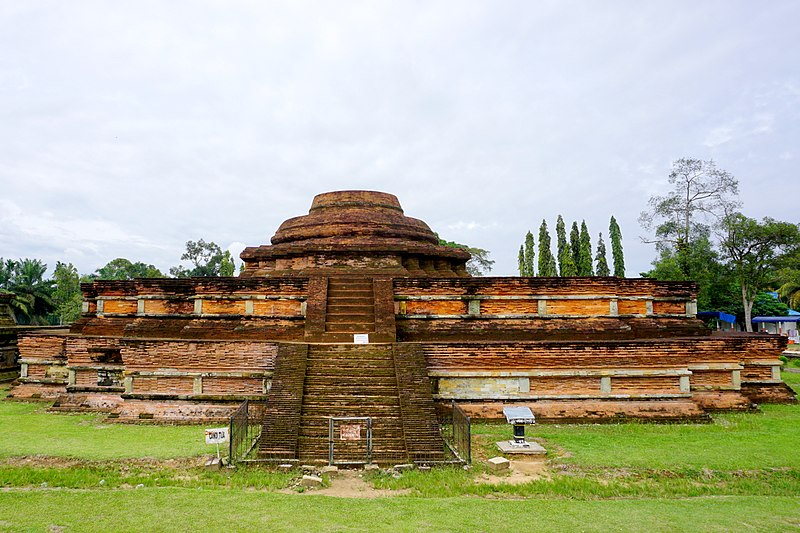
Photo by https://commons.wikimedia.org/wiki/File:007_Candi_Tua_from_East,_Main_Entrance_%2838244913275%29.jpg 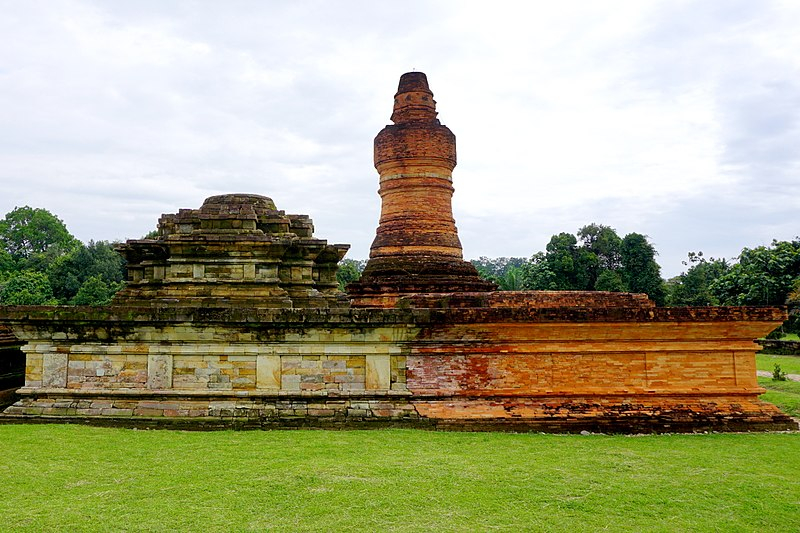
Photo by https://commons.wikimedia.org/wiki/File:015_Candi_Bungsu_with_Mahligai_in_Background_%2827349645889%29.jpg












